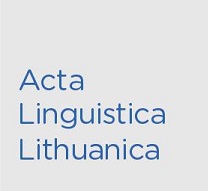Funkcinis reciprokinių žymeklių monadinėse konstrukcijose aspektas
Functional Aspect of Reciprocal Markers in Monadic Constructions
Author(s): Loreta Vaičiulytė-SemėnienėSubject(s): Language studies, Morphology, Semantics, Baltic Languages, Philology
Published by: Lietuvių Kalbos Institutas
Keywords: reciprocal verb; mutuant; reciprocal monadic constructions; reciprocal marker; semantic parameter;
Summary/Abstract: Reciprocal markers used in monadic constructions with the meaning of mutual action or reciprocal verbs are analysed in the article, based on the Corpus of the Contemporary Lithuanian Language (CCLL). The object of the article is to discuss, focusing on the functional aspect, what is actualised and specified by one or another reciprocal marker. The study shows that a hierarchy of reciprocal markers can be distinguished according to possible segmentation of mutuants that are expressed as subject and orientation to subject resp. predicate, i.e., the actualisation and specification of the subject and predicate: one with the other > among themselves > between themselves > reciprocity > mutual / mutually / reciprocally (Lith. vienas su kitu > tarp savęs > tarpusavyje > savitarpyje > abipusiai / abipusiškai / savitarpiškai). Reciprocal markers one with the other, among themselves, between themselves, reciprocity, mutual, mutually, reciprocally that express interrelation and actualise and specify it are modifiers. Some reciprocal markers are (more) subject-oriented (one with the other), others are more oriented to the predicate of the meaning of the mutual action itself (mutually / reciprocally). CCLL data indicates that markers related to the reciprocal verb itself are used sporadically, i.e., the manner of expressing mutual action itself is rarely actualised. Reciprocal markers semantically linked with mutuants expressed as subject are used the most frequently: they actualise together or separately understood mutuants expressed as subject. As to the segmentation of mutuants of mutual situation that are expressed as subject, significant is separate : seamless, or individual : collective (Lith. individualus : kolektyvinis) parameter that correlates with the usage of reciprocal markers one with the other > among themselves > between themselves. Reciprocal anaphora one with the other actualises every separate mutuant as a member of the whole expressed as subject; mutual relation of mutuants in a group that is regarded as more closed off or closed as (more or less) indivisible, i.e., seamless, whole is actualised by reciprocal marker among themselves or between themselves respectively. The actualisation of the participants of the mutual relation corresponds to the differences of perspective, point of view: in the sentences with a reciprocal anaphora one with the other, each participant of a mutual situation seems to be visible individually, in the sentences with between themselves, an individual mutuant participating in a mutual situation seems to be shifted to the background, i.e., becomes irrelevant and all mutuants are considered together, i.e., as a whole. In the context reciprocal marker among themselves can get closer to a specifier of mutual relation of separate mutuants, i.e., reciprocal anaphora one with the other, or reciprocal marker between themselves can get closer to it. According to orientation or subject resp. predicate actualisation and specification and segmentation the mutuants that are expressed as subject, reciprocal markers range hierarchically: one with the other > among themselves > between themselves > reciprocity > mutual / mutually / reciprocally. Reciprocal between themselves is like a relative transition from being subject-oriented to being predicate-oriented. Additionally, possible usage of reciprocal markers is also influenced by the differences of the meaning of predicate aspect, participle configurations, sequence parameter and actualisation of atypical mutual situations. In these cases, the usage of reciprocal between themselves is (possibly) limited.
Journal: Acta Linguistica Lithuanica
- Issue Year: 2017
- Issue No: 76
- Page Range: 105-133
- Page Count: 29
- Language: Lithuanian

